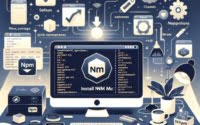How-to Get Latest Stable Version of NPM | Update Guide

We understand the importance of staying current with software updates, especially in a dynamic work environment like IOFLOOD.
Recognizing the common need to keep development tools current, we’ve crafted this guide to assist developers in easily updating npm to the latest version. Recognizing the importance help other developers facing similar challenges, we’ve created this guide on updating npm to the latest version.
This guide will walk you through the process of updating to the latest npm version, ensuring your development environment stays efficient and secure. With the ever-evolving landscape of JavaScript development, staying updated with the latest npm version is not just a recommendation; it’s a necessity for any serious developer.
Let’s dive into the process of updating npm to the latest version and unlock the features and improvements it has to offer!
TL;DR: How Do I Update npm to the Latest Version?
To update npm to the latest version, use the command
npm install npm@latest -g.
Here’s a quick example:
npm install npm@latest -g
# Output:
# + [email protected] updated
This command updates npm globally to the latest version, ensuring that all your global npm packages have access to the latest features, performance improvements, and security patches. By keeping npm up-to-date, you’re not only enhancing your development environment but also safeguarding your projects against potential vulnerabilities.
Keep reading for more detailed instructions, troubleshooting tips, and best practices for ensuring your npm is always at its peak performance.
Table of Contents
Check Your npm Version Easily
Before diving into the update process, it’s essential to know which version of npm you’re currently using. This can be achieved with a simple command:
npm -v
# Output:
# 6.14.8
The output shows your current npm version, in this case, 6.14.8. Knowing your version is crucial as it helps you understand whether an update is necessary, especially if you’re troubleshooting or ensuring compatibility with other tools or packages.
Update npm Globally: The Basics
Updating npm to its latest version is straightforward, thanks to the npm team’s efforts to make the process as seamless as possible. The -g flag in the command npm install npm@latest -g signifies a global update, meaning it updates the npm tool across your entire system, not just in your current project.
Here’s what happens when you run the command:
npm install npm@latest -g
# Output:
# + [email protected] updated
After executing the command, you’ll see a confirmation message, like + [email protected] updated, indicating the successful global update to the latest version. This process ensures that all your global npm packages are up-to-date.
Why Update Globally?
Updating npm globally is advantageous because it ensures that every project you work on uses the latest npm features and security patches. This is particularly important for developers who manage multiple projects or use npm for various tools and utilities outside of project-specific dependencies. The -g flag makes this process easy and efficient, although it may require additional steps or configurations on certain systems to address permissions or path issues.
Pros and Cons
Pros:
– Easy and quick update process.
– Ensures your global npm environment is up-to-date.
Cons:
– May require additional steps on certain systems, such as adjusting permissions or modifying system path settings.
By understanding these basic use cases, even beginners can confidently manage their npm versions, keeping their development environment efficient and secure.
Advanced Version Management: NVM
For developers seeking more control over their npm and Node.js versions, Node Version Manager (NVM) offers a powerful solution. NVM allows you to install multiple versions of Node.js and npm, enabling you to switch between them as needed. This flexibility is especially beneficial for projects that require specific versions of npm or Node.js.
Installing and Using NVM
First, ensure NVM is installed on your system. If not, you can find installation instructions on the NVM GitHub page. Once installed, you can easily switch to the latest version of Node.js, which includes the latest npm version, using the following commands:
nvm install node # Installs the latest version of node and npm
nvm use node # Switches to the latest version
# Output:
# Now using node v15.3.0 (npm v7.0.14)
The command nvm install node fetches and installs the latest version of Node.js and npm. Following this, nvm use node switches your environment to use the newly installed versions. The output confirms the versions of Node.js and npm that are currently active, illustrating the ease with which you can manage and update your development tools.
Why Choose NVM?
Pros:
– Offers the ability to manage multiple Node.js and npm versions easily.
– Facilitates project-specific version control, enhancing compatibility and reducing the risk of conflicts.
Cons:
– Requires an initial setup and familiarization with NVM commands.
– Can introduce complexity for users new to version management tools.
Using NVM to manage and update npm versions represents an intermediate level of npm usage. It provides developers with greater control over their development environment, allowing for more precise management of project dependencies. Whether you’re working on a large-scale project or managing several smaller projects with different requirements, NVM can significantly streamline your workflow and ensure that you’re always using the most appropriate versions of npm and Node.js.
Best Version Management Practices
When it comes to managing npm versions at an expert level, automation and containerization stand out as advanced strategies. These methods streamline the update process, minimize manual effort, and ensure consistency across development environments.
Automating npm Updates
Automated update scripts can significantly reduce the manual effort involved in keeping npm up-to-date. By leveraging cron jobs or CI/CD pipelines, you can schedule and execute npm updates without manual intervention.
Consider this example of a simple Unix/Linux cron job setup to update npm weekly:
0 0 * * 0 npm install npm@latest -g > /var/log/npm-update.log
# Output in /var/log/npm-update.log might show:
# + [email protected] updated
This cron job runs at midnight every Sunday, updating npm to the latest version globally and logging the output. It’s a set-and-forget solution that ensures your npm version remains current without requiring constant manual checks.
Using Docker for Consistent npm Versions
Docker containers offer another powerful approach to manage npm versions, especially in team environments or CI/CD pipelines. By specifying the npm version in your Dockerfile, you can ensure that every instance of your application runs with the exact version of npm, eliminating discrepancies between development and production environments.
Here’s how you might specify npm in a Dockerfile:
FROM node:14
RUN npm install npm@latest -g
This Dockerfile starts with a base image of Node.js version 14 and updates npm to the latest version globally within the container. This approach guarantees that the npm version is consistent across all instances, enhancing reliability and predictability in your development workflow.
Pros and Cons of Advanced Strategies
Pros:
– Automates updates, significantly reducing manual effort.
– Ensures consistent npm versions across development environments.
Cons:
– Requires upfront setup and configuration.
– May introduce complexity, especially for teams new to automation or containerization.
By adopting these expert-level strategies for npm version management, you can achieve a more efficient, consistent, and secure development process. Whether through automation or containerization, these approaches offer powerful tools to keep your npm version management ahead of the curve.
Troubleshooting npm Update Issues
When updating to the npm latest version, developers might encounter a few common issues. Understanding these problems and knowing how to resolve them ensures a smooth update process.
Handling Permission Errors
One of the frequent hurdles is permission errors, especially when updating npm globally without sufficient access rights. This issue often presents itself with an EACCES error code. A straightforward solution involves prefixing the update command with sudo, granting temporary administrative rights for the operation:
sudo npm install npm@latest -g
# Output:
# + [email protected] updated
Using sudo elevates your privileges for the duration of the command, allowing npm to update successfully. Remember, while this method is effective, regularly using sudo for npm operations could expose your system to risks. It’s advisable to configure npm to work without sudo for everyday use.
Resolving Version Conflicts
Version conflicts can arise when a project’s dependencies specify different npm versions. A common approach to resolving these conflicts is by using the npm dedupe command, which attempts to streamline dependency versions within a project:
npm dedupe
# Output:
# Updated 3 packages
npm dedupe optimizes the node_modules tree, aiming to reduce duplication by merging compatible versions. This command can help resolve conflicts and reduce the overall size of your project’s dependencies.
Best Practices for npm Version Management
- Stay Informed: Regularly check npm’s release notes and update notifications.
- Use Version Management Tools: Tools like nvm (Node Version Manager) can help manage different npm versions without conflicts.
- Test Before Updating: Before applying a global update, test the new npm version in a controlled environment to ensure compatibility with your projects.
By anticipating common issues and adopting best practices, developers can navigate the challenges of updating npm, maintaining an efficient and secure development environment.
JavaScript Importance of npm
npm, or Node Package Manager, serves as the backbone of JavaScript development, providing a vast repository of packages that developers can easily incorporate into their projects. It’s not just a package manager; it’s a powerful tool that streamlines dependency management, version control, and package distribution, making it indispensable for modern web development.
npm and Semantic Versioning
npm adheres to semantic versioning, or semver, a standard for versioning software that’s crucial for managing dependencies effectively. Semantic versioning is represented by three numbers: major, minor, and patch (e.g., 1.4.2), each signifying the type of changes in the release:
- Major version updates (1.x.x to 2.x.x) introduce significant changes that may not be backward compatible.
- Minor version updates (x.1.x to x.2.x) add functionality in a backward-compatible manner.
- Patch version updates (x.x.1 to x.x.2) make backward-compatible bug fixes.
Understanding the significance of these updates is crucial for maintaining project stability and compatibility. For instance, updating a project to a new major version of a package without proper testing could introduce breaking changes.
The Role of npm in Project Dependencies
To illustrate the role of npm in managing project dependencies, consider the following example:
"dependencies": {
"express": "^4.17.1"
}
In this package.json snippet, the caret (^) before the version number indicates that the project is compatible with minor updates and patch updates of Express 4.17.1. npm automatically manages these updates, ensuring that the project uses the latest compatible version of Express without manual intervention.
This automation is a double-edged sword; it simplifies dependency management but also underscores the importance of keeping npm itself updated. An outdated npm might not handle dependency updates effectively, potentially leading to compatibility issues or missing out on critical security patches.
By understanding npm’s role and the principles of semantic versioning, developers can better manage their projects’ dependencies, ensuring that their applications remain secure, stable, and up-to-date. Keeping npm updated is a key part of this process, enabling developers to leverage the latest features and improvements in the npm ecosystem.
Practical Usage of npm Updates
The journey of JavaScript development doesn’t end with updating npm; rather, it opens a new chapter where efficiency, security, and dependency management become more streamlined. With the latest npm version, developers gain access to improved features that can significantly impact larger projects.
Dependency Management and Security
One of the key benefits of staying updated with npm is enhanced security through better dependency management. The package-lock.json plays a pivotal role here, ensuring that the exact versions of the dependencies are locked down, thus avoiding unexpected changes.
npm install
# Output:
# added 125 packages, and audited 126 packages
After running npm install in a project with an updated npm version, you’ll notice the package-lock.json file is automatically generated or updated. This file is crucial for maintaining consistent installations across different environments, reducing the “It works on my machine” syndrome.
Security Auditing with npm audit
Another significant advantage of the latest npm version is the built-in security auditing feature, npm audit. This command scans your project’s dependencies for known security vulnerabilities and provides recommendations for mitigation.
npm audit
# Output:
# found 0 vulnerabilities
The output of npm audit reassures that your project is free of known vulnerabilities, a critical aspect for maintaining the integrity and security of your applications. It’s a powerful tool that underscores the importance of regular updates to npm.
Further Resources for npm Version Mastery
To deepen your understanding and skills in managing npm versions and leveraging the full potential of npm in your projects, consider exploring these resources:
- npm Documentation: The official npm documentation is a comprehensive resource covering all aspects of npm, from basic usage to advanced features.
Node.js Guides: These guides provide insights into various Node.js topics, including npm version management.
The npm Blog: Stay updated with the latest news, updates, and best practices in the npm ecosystem by following the npm blog.
By utilizing these resources, developers can further enhance their knowledge and skills in npm, ensuring their projects are not only up-to-date but also secure, efficient, and scalable.
Recap: Updating to Latest npm
In this comprehensive guide, we’ve walked through the essential steps to update npm to its latest version, a critical task for any JavaScript developer aiming to keep their toolbox modern and secure. Keeping npm updated ensures that your development environment benefits from the latest features, performance improvements, and security patches.
We began with the basics, showing you how to check your current npm version and update it globally with a simple command. This foundational knowledge is crucial for all developers, ensuring that everyone can start their projects on the right foot.
Moving to more advanced techniques, we explored how tools like NVM (Node Version Manager) offer greater control over npm and Node.js versions. This allows developers to tailor their environment to specific project needs, providing flexibility and precision in version management.
For experts, we delved into automated update scripts and Docker containers as sophisticated strategies to manage npm versions. These approaches minimize manual effort and ensure consistency across development environments, showcasing the depth of options available for npm version management.
| Strategy | Ease of Use | Control Level |
|---|---|---|
| Global Update | High | Low |
| NVM | Medium | High |
| Automation/Docker | Low | Very High |
Whether you’re a beginner just getting to grips with npm, or an experienced developer looking to streamline your version management, this guide has provided the insights and tools necessary to keep your npm version current. By staying updated, you not only enhance your own development experience but also contribute to the security and stability of the wider JavaScript ecosystem.
Updating npm is more than a technical necessity; it’s a commitment to professional growth and project excellence. As you continue to explore the vast landscape of npm and JavaScript development, remember the importance of keeping your tools sharp and your knowledge current. Happy coding!


